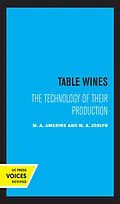Table Wines: The Technology of Their Production, Second Edition by M. A. Amerine and M. A. Joslyn is a comprehensive guide to the economic and technical challenges shaping the modern wine industry. The authors address the central problems of rising production costs and the imperative to maintain or improve wine quality, situating their discussion within the broader context of competitive food industries. Drawing on extensive research at the University of California and first-hand observations of wine production practices worldwide, Amerine and Joslyn emphasize the crucial role of mechanization, plant design, and process optimization in balancing efficiency with excellence. Their analysis highlights both the pitfalls of entrenched practices and the opportunities to produce fine, consistent wines capable of competing in discerning markets.
Organized as a practical handbook, the volume covers every stage of table wine production, from equipment selection and fermentation practices to bottling and labeling, with individual chapters devoted to specific wine types. Recognizing that winemaking is both a biological process and an art, the authors devote their final chapters to the principles of grape composition and fermentation science, underscoring that innovation in practice must rest on sound technical knowledge. By combining economic insights, regulatory considerations, and scientific principles with practical guidance, Table Wines offers producers, chemists, and technicians an indispensable reference for advancing both the quality and profitability of table wines in California and beyond.
This title is part of UC Press's Voices Revived program, which commemorates University of California Press's mission to seek out and cultivate the brightest minds and give them voice, reach, and impact. Drawing on a backlist dating to 1893, Voices Revived makes high-quality, peer-reviewed scholarship accessible once again using print-on-demand technology. This title was originally published in 1970.
Autorentext
Enter the Author Bio(s) here.
